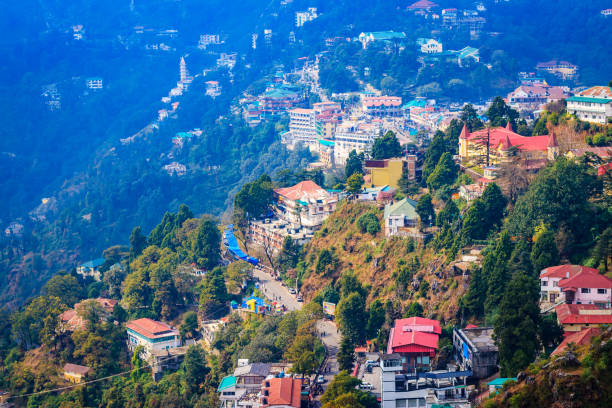Mussoorie - The Queen of Hills-India
Hill Station Mussoorie
Mussoorie is a hill station and a municipal board in the Dehradun district of the Indian state of Uttarakhand. It is about 35 kilometres (22 mi) from the state capital of Dehradun and 290 km (180 mi) north of the national capital of New Delhi. The hill station is in the foothills of the Garhwal Himalayan range. The adjoining town of Landour, which includes a military cantonment, is considered part of "greater Mussoorie", as are the townships of Barlowganj and Jharipani.
Mussoorie is at an average altitude of 2,005 metres (6,578 ft). To the northeast are the Himalayan snow ranges, and to the south, the Doon Valley and Shiwalik ranges. The second highest point is the original Lal Tibba in Landour, with a height of over 2,275 m (7,464 ft). Mussoorie is popularly known as The Queen of the Hills
The name Mussoorie is often attributed to a derivation of mansūr, a shrub which is indigenous to the area. The town is often referred to as Mansuri by Indians.[5]
In 1803 the Gorkhas under Umer Singh Thapa conquered the Garhwal and the Dehra, whereby Mussoorie was established. On 1 November 1814, a war broke out between the Gorkhas and the British. Dehradun and Mussoorie were evacuated by the Gorkhas by the year 1815 and were annexed to the district of Saharanpur by 1819.
Mussoorie as a resort was established in 1825 by Captain Young, a British military officer. With Mr Shore, the resident Superintendent of Revenues at Dehradun, he explored the present site and jointly constructed a shooting lodge.[6] Lt. Frederick Young of the East India Company came to Mussoorie to shoot game.[citation needed] He built a hunting lodge (shooting box) on the Camel's Back Road, and became a magistrate of Doon in 1823. He raised the first Gurkha Regiment and planted the first potatoes in the valley. His tenure in Mussoorie ended in 1844, after which he served in Dimapur and Darjeeling, later retiring as a General and returning to Ireland.[citation needed] There are no memorials to commemorate Young in Mussoorie. However, there is a Young Road in Dehradun on which ONGC's Tel Bhawan[clarification needed] stands.[citation needed]
In 1832, Mussoorie was the intended terminus of the Great Trigonometric Survey of India that began at the southern tip of the country. Although unsuccessful, the Surveyor General of India at the time, George Everest, wanted the new office of the Survey of India to be based in Mussoorie; a compromise location was Dehradun, where it remains.[citation needed] The same year the first beer brewery at Mussoorie was established by Sir Henry Bohle as "The Old Brewery". The brewery opened and closed twice before it was re-established by Sir John Mackinnon as Mackinnon & Co. in 1850.[7]
By 1901 Mussoorie's population had grown to 6,461, rising to 15,000 in the summer. Earlier, Mussoorie was approachable by road from Saharanpur, 58 miles (93 km) away. Accessibility became easier in 1900 with the railway coming to Dehradun, thus shortening the road trip to 21 miles (34 km).[8]
Kempty Falls view from the top of the hill. Kempty Fall is 15 km (9.3 mi) from Mussoorie along Kempty Fall Road
Another view from top of a Hill
The Nehru family, including Nehru's daughter Indira (later Indira Gandhi) were frequent visitors to Mussoorie in the 1920s, 1930s, and 1940s, and stayed at the Savoy Hotel.[9] They also spent time in nearby Dehradun, where Nehru's sister Vijayalakshmi Pandit ultimately settled full-time
Mussoorie has an average elevation of about 2,005 metres (6,578 ft). The highest point is "Lal Tibba", at a height of about 2,275 m (7,464 ft), although the name Lal Tibba is now also used to describe a lookout point, a short distance from the peak.
Mussoorie has a fairly typical subtropical highland climate (Köppen Cwb) for the mid-altitude Himalaya. Summers are warm and very wet, with July and August averaging approximately 660 millimetres (26 in) of rain per month due to orographic lift of the extremely moist monsoonal air. The pre-monsoon seasons in April and May is warm to very warm and generally dry and clear, giving way to heavy rainfall from mid-June, while the post-monsoon season is also dry and clear but substantially cooler. In winter, rainfall is a little more frequent than in the pre-and post-monsoon seasons, and the general weather cool and partly cloudy. Mussoorie usually receives a few spells of snowfall in December, January and February, although the number of snowy days has come down in recent years due to a combination of local and global factors, such as deforestation, construction activity and global warming.[citation needed] Between October to February the town shows the rare "winterline" phenomenon







0 comments